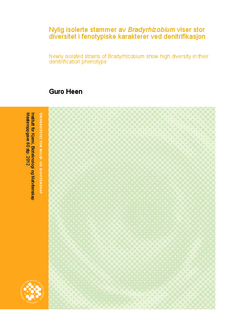| dc.description.abstract | Sammendrag
Denitrifikasjon er en respiratorisk prosess som utføres av mange prokaryoter under anoksiske
forhold. Under denitrifikasjonsprosessen reduseres nitrat (NO3
-
) til nitritt (NO2
-
) og videre til
gassene nitrogenmonooksid (NO), lystgass (N2O) og molekylært nitrogen (N2). For å utføre
en fullstendig denitrifikasjon kreves de fire reduksjonsenzymene: nitrat reduktase (Nar/Nap),
nitritt reduktase (Nir), nitrogenmonooksid reduktase (Nor) og dinitrogenokside reduktase
(Nos). Til dags dato er denitrifikasjon kun studert på noen få modellorganismer, og det er
ingen god kjennskap mellom fylogeni og funksjon. Hovedforskjellen mellom de
denitrifiserende bakterier viser seg å være hvor mye gass som blir emittert av NO, N2O og N2.
Denitrifikasjons prosessen kan bli trunkert dersom en organsime mangler et eller flere
denitrifikasjonsgener, men den kan også påvirkes av faktorer som lav pH. En trunkert
denitrifikasjon resulterer i utslipp av NO eller N2O. N2O er en klimagass som bryter ned
ozonlaget og er 310 ganger større globalt oppvarmingspotensial enn CO2.
Denne oppgaven karakteriserer regulatoriske fenotyper av denitrifiserende organismer (DRP)
for ulike stammer av Bradyrhizobium ved å studere gasskinetikk, samt ekspresjon av nirK og
nosZ i overgangen fra oksiske til anoksiske forhold. DRP er en fellesbetegnelse for en rekke
fenotypiske og regulatoriske karakteristikker som blir bestemt gjennom standardiserte
eksperimenter. Det ble utført en sluttpunktanalyse for å få en generell oversikt over de 39
Bradyrhizobium stammenes siste reduksjonssteg i denitrifikasjonen. Ut i fra disse resultatene
ble det valgt ut tre stammer (79b1, 87j1 og 104a) som hadde N2 som sluttprodukt, og som
viste en viss fylogenetisk avstand mellom hverandre. Denitrifikasjonsmønstret til de tre
stammene ble registrert i et semiautomatisk inkuberingssystem hvor gassene CO2, O2, NO,
N2O og N2 ble målt. Transkripsjonen av nirK og nosZ ble kvantifisert for 79b1 og 104a
gjennom Real Time PCR. Transkripsjonen ble linket til gasskinetikken og sammenliknet
mellom de to stammene. Transkripsjonsanalysene viste at ekspresjon for nirK og nosZ økte
når oksygenkonsentrasjonen ble lav. For samtlige av stammene var ekspresjonen for nosZ
generelt lavere enn nirK. Under transkripsjonsanalysene hadde kulturene et høyere celletall en
hva som var blitt benyttet i tidligere forsøk. Dette resulterte i en raskere overgang fra et oksisk
til et anoksisk miljø. Under en slik rast transisjon viste stamme 104a en høy akkumulering
NO, mens stamme 79b1 viste en stringent kontroll over NO produksjon. Stamme 104a viste
også en liten produksjon av N2 under samtlige av gasskinetikk-forsøkene, noe som kan bety at
den redusere mesteparten av nitratet til ammonium gjennom DNRA. Denne oppgaven viser fenotypisk data fra ulike Bradyrhizobium stammer. Dette vil være med
på å støtte vår forståelse for denitrifikasjon og gi grunnlag for formulering og kalibrering av
en biokjemisk modell med hensikt for å kunne forutsi responsen i et denitrifiserende
mikrobielt samfunn. Med en slik modell kunne vi motvirke utslipp av drivhusgass fra
jordbruksområder. Abstract
Denitrification is a respiratory process that is carried out by many prokaryotes under anoxic
conditions. During the process of denitrification, nitrate (NO3
-
) is reduced to nitrite (NO2
-
)
and further on to the gases nitric oxide (NO), nitrous oxide (N2O) and molecular nitrogen
(N2). Four reductases are necessary to carry out complete denitrification: nitrate reductase
(Nar or Nap), nitrite reductase (Nir), nitric oxide reductase (Nor) and nitrous oxide reductase
(Nos). To date, denitrification is only studied in a few model organisms, and the relationship
between phylogeny and phenotype is not well understood. The main difference between
denitrifiers is the amount of gas that is emitted in form of NO, N2O and N2. Denitrification
can be truncated if organisms lack one or more of the denitrification genes, but the process
can also be affected by environmental factors like low pH. A truncated denitrification results
in the emission of NO or N2O. The latter is a greenhouse gas that destroys the ozone layer and
has a global warming potential 310 times that of CO2.
This paper characterizes the denitrification regulatory phenotype (DRP) of different strains of
Bradyrhizobium by studying gas kinetics, and the expression of nirK and nosZ during the
transition from oxic to anoxic conditions. DRP is a collection of traits for a variety of
phenotypic and regulatory characteristics that are determined through standardized
experiments. An end-point analysis was preformed to obtain a general overview of the last
reduction step in denitrification for 39 strains of Bradyrhizobium. Based on the results, three
strains (79b1, 87j1 and 104a) were selected that had N2 as end product, and showed a certain
phylogenetic distance to each other. The denitrification patterns of these three strains were
determined in a semi-automatic incubation system where the gases CO2, O2, NO, N2O and N2
were measured. The transcription of nirK and nosZ was quantified for strains 79b1 and 104a
by Real Time PCR. The transcription was linked to gas kinetics and compared between the
two strains. Expression of nirK and nosZ increased after oxygen depletion. For both strains,
expression of nosZ was generally lower than that of nirK. Cultures were grown to higher cell
numbers for transcription analysis than for previous experiments, which resulted in a quicker
transition from oxic to anoxic conditions. This caused high NO production and accumulation
in strain 104a, while strain 79b1 had stringent control over NO production. Strain 104a also
showed a low production of N2 in all gas-kinetic experiments, which indicates that the fate of
nitrate was another than denitrification, for example reduction to ammonium in DNRA.
This thesis provides phenotypic data from different strains of Bradyrhizobium and thereby
supports our understanding of denitrification and aids the formulation and calibration of a biochemical model with the goal to predict the response of a denitrifying microbial
community to external factors. Such a model would enable us to counteract greenhouse gas
emissions from agricultural sites. | no_NO |
